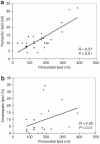The relationship of ectopic lipid accumulation to cardiac and vascular function in obesity and metabolic syndrome
- PMID: 19875992
- PMCID: PMC3264050
- DOI: 10.1038/oby.2009.363
The relationship of ectopic lipid accumulation to cardiac and vascular function in obesity and metabolic syndrome
Abstract
Storage of lipid in ectopic depots outside of abdominal visceral and subcutaneous stores, including within the pericardium and liver, has been associated with obesity, insulin resistance, and cardiovascular risk. We sought to determine whether anatomically distinct ectopic depots were physiologically correlated and site-specific effects upon cardiovascular function could be identified. Obese subjects (n = 28) with metabolic syndrome but without known atherosclerotic disease and healthy controls (n = 18) underwent magnetic resonance imaging (MRI) and proton MR spectroscopy (MRS) to quantify pericardial and periaortic lipid volumes, cardiac function, aortic compliance, and intrahepatic lipid content. Fasting plasma lipoproteins, glucose, insulin, and free-fatty acids were measured. Pericardial and intrahepatic (P < 0.01) and periaortic (P < 0.05) lipid volumes were increased in obese subjects vs. controls and were strongly and positively correlated (P <or= 0.01) but independent of BMI (P = NS) among obese subjects. Intrahepatic lipid was associated with insulin resistance (P < 0.01) and triglycerides (P < 0.05), whereas pericardial and periaortic lipid were not (P = NS). Periaortic and pericardial lipid positively correlated to free-fatty acids (P <or= 0.01) and negatively correlated to high-density lipoprotein (HDL) cholesterol (P < 0.05). Pericardial lipid negatively correlated to cardiac output (P = 0.03) and stroke volume (P = 0.01) but not to left ventricular ejection fraction (P = 0.46). None of the ectopic depots correlated to aortic compliance. In conclusion, ectopic storage of lipid in anatomically distinct depots appeared tightly correlated but independent of body size. Site-specific functional abnormalities were observed for pericardial but not periaortic lipid. These findings underscore the utility of MRI to assess individual differences in ectopic lipid that are not predictable from BMI.
Figures



References
-
- Poirier P, Giles TD, Bray GA, et al. American Heart Association Obesity and cardiovascular disease: pathophysiology, evaluation, and effect of weight loss: an update of the 1997 American Heart Association Scientific Statement on Obesity and Heart Disease from the Obesity Committee of the Council on Nutrition, Physical Activity, and Metabolism. Circulation. 2006;113:898–918. - PubMed
-
- Eckel RH, Grundy SM, Zimmet PZ. The metabolic syndrome. Lancet. 2005;365:1415–1428. - PubMed
-
- Després JP, Lemieux I, Bergeron J, et al. Abdominal obesity and the metabolic syndrome: contribution to global cardiometabolic risk. Arterioscler Thromb Vasc Biol. 2008;28:1039–1049. - PubMed
-
- Lettner A, Roden M. Ectopic fat and insulin resistance. Curr Diab Rep. 2008;8:185–191. - PubMed
-
- McGavock JM, Lingvay I, Zib I, et al. Cardiac steatosis in diabetes mellitus: a 1H-magnetic resonance spectroscopy study. Circulation. 2007;116:1170–1175. - PubMed
Publication types
MeSH terms
Grants and funding
LinkOut - more resources
Full Text Sources
Medical
Miscellaneous

